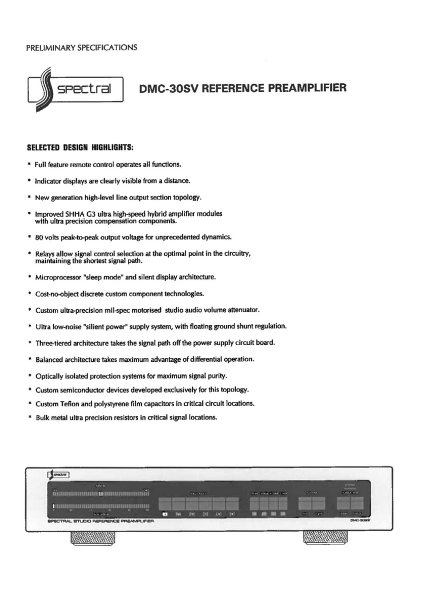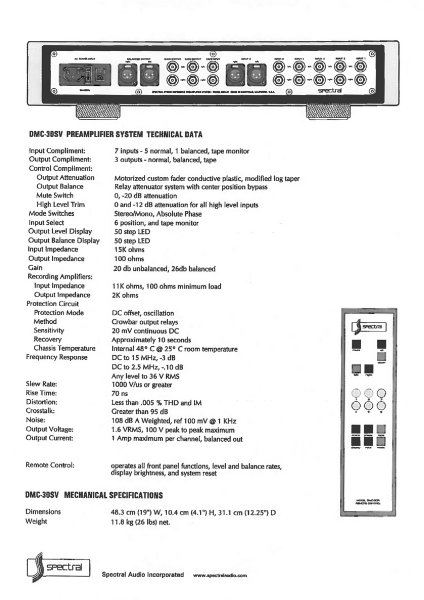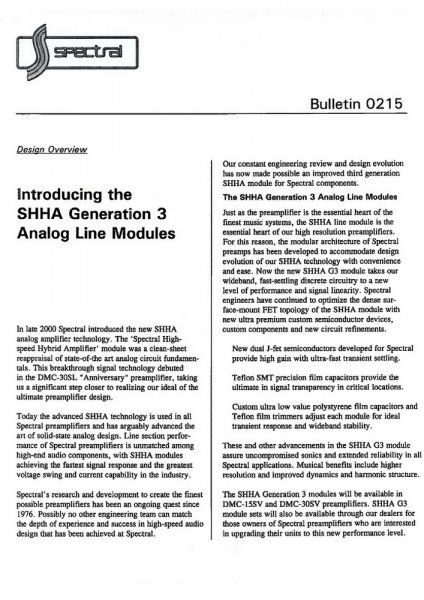Spectral DMC-30 SV
- Thread starter ack
- Start date
You are using an out of date browser. It may not display this or other websites correctly.
You should upgrade or use an alternative browser.
You should upgrade or use an alternative browser.
Thanks for the reply Ack. I'm not current on Spectral offerings since they lost their local presence. I'll have to read up on the RS power amps, and if I want to hear anything it means flying to one of the coasts, which I might do one of these days.
Last edited:
It's a pain, isn't it. I just realized that www.theaudiosalon.com no longer carries the line.. that's too bad
The SHHA3 modules
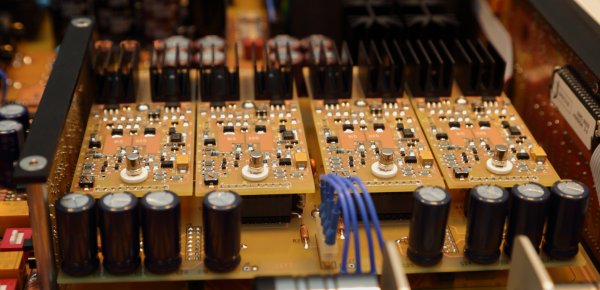
Another angle, showing [what I think is] the new balanced input board in the foreground (vertical board)
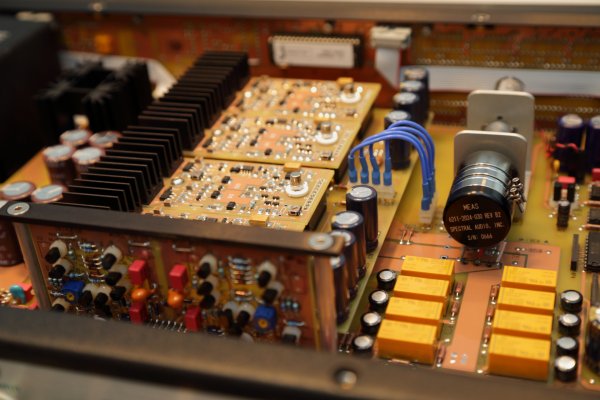
A lot of these parts, including amplification devices, are said to be custom (starting with the volume pot on the right - something that first appeared in the 30SS). You have to hear it to believe what this thing does.

Another angle, showing [what I think is] the new balanced input board in the foreground (vertical board)

A lot of these parts, including amplification devices, are said to be custom (starting with the volume pot on the right - something that first appeared in the 30SS). You have to hear it to believe what this thing does.
I won't get mine until the end of the year, it seems.
I picked up the following picture from the net of the DMC-6 from the late 80s I think - talking about circuit design, roughly 30 years ago

I picked up the following picture from the net of the DMC-6 from the late 80s I think - talking about circuit design, roughly 30 years ago

At first I thought it must be a typo (15 MHz should have been 1.5 MHz like the 30SS spec), but then I noticed that the DC to 2.5 MHz spec is -.10 dB (down only 1/10th dB instead of 10 dB). So the numbers as shown might be correct, and if so show a much more extended bandwidth, being down 3 dB at 15 MHz instead of at 1.5 MHz.
At first I thought it must be a typo (15 MHz should have been 1.5 MHz like the 30SS spec), but then I noticed that the DC to 2.5 MHz spec is -.10 dB (down only 1/10th dB instead of 10 dB). So the numbers as shown might be correct, and if so show a much more extended bandwidth, being down 3 dB at 15 MHz instead of at 1.5 MHz.
These are most likely typos, both the 15 MHz and the .10 dB.
The 30SV bulletin is out (notice the date, 01/2015) http://spectralaudio.com/bulletins/NL-0115.pdf
And like the RS amplifiers, a claim of no thermal tails
Utilizing recent breakthrough understanding in high-speed transistor behavior, new semiconductor designs exclusive to Spectral address historic limitations in amplifier linearity and banish low-level distortion products to previously unattainable levels. These devices and a new family of exotic custom made passive components are utilized in a new generation of high-speed, wide-band input stage and high-level line sections with unprecedented results.
And like the RS amplifiers, a claim of no thermal tails
Thanks for posting the link to the 30SV bulletin.
A lot of marketing hype. Too bad for a company that is truly state of the art. That is probably how you survive so long in the high end arena.
The "thermal tails" stuff is old news. It used to be new when the world switched from hollow state to solid state and wide band, open loop, amplifier were the last frontier. Probably a long forgotten issue for engineers using ICs almost exclusively nowadays. Not sure how applicable to modern topologies could be...
Bandwidth alone, whether 1.5Mhz or 15MHz, doesn't tell the whole truth. A settling time specs has never been published AFAIK.
The SHHA module had a facelift with the introduction of the metal can dual J-Fet. I'm quite sure this is a re-badged LSK389C from Linear Integrated System. All the previous iteration of the SHHA module used the unobtanium National NPD5566. Spectral should have depleted their stash of the old National IC and is now going with its modern replacement. Disappointing to see they didn't change the footprint on the PCB but decided to go with two teflon bases instead. After all the thermal tails of yesteryear have been eliminated by finer geometries. Using a through hole component when there is an equivalent SMD part available isn't a good idea as well. There must be a lot of PCBs with the old footprint sitting on the shelf. The SMD part is waiting for the Super Velocissimo version to come. Velocissimo is the Italian superlative of veloce, veloce means fast, BTW. "Developed exclusively for us": no way. Repackaged? Maybe. Anyone familiar with the semiconductor industry and the high end volumes knows what I mean.
Cannot comment on the teflon trimmers and polystyrene SMT caps. Too small to see, all the SMD caps looks the same but quality can differ by orders of magnitude.
The new balanced input board is the real news here. It would be interesting to see a close up picture.
A lot of marketing hype. Too bad for a company that is truly state of the art. That is probably how you survive so long in the high end arena.
The "thermal tails" stuff is old news. It used to be new when the world switched from hollow state to solid state and wide band, open loop, amplifier were the last frontier. Probably a long forgotten issue for engineers using ICs almost exclusively nowadays. Not sure how applicable to modern topologies could be...
Bandwidth alone, whether 1.5Mhz or 15MHz, doesn't tell the whole truth. A settling time specs has never been published AFAIK.
The SHHA module had a facelift with the introduction of the metal can dual J-Fet. I'm quite sure this is a re-badged LSK389C from Linear Integrated System. All the previous iteration of the SHHA module used the unobtanium National NPD5566. Spectral should have depleted their stash of the old National IC and is now going with its modern replacement. Disappointing to see they didn't change the footprint on the PCB but decided to go with two teflon bases instead. After all the thermal tails of yesteryear have been eliminated by finer geometries. Using a through hole component when there is an equivalent SMD part available isn't a good idea as well. There must be a lot of PCBs with the old footprint sitting on the shelf. The SMD part is waiting for the Super Velocissimo version to come. Velocissimo is the Italian superlative of veloce, veloce means fast, BTW. "Developed exclusively for us": no way. Repackaged? Maybe. Anyone familiar with the semiconductor industry and the high end volumes knows what I mean.
Cannot comment on the teflon trimmers and polystyrene SMT caps. Too small to see, all the SMD caps looks the same but quality can differ by orders of magnitude.
The new balanced input board is the real news here. It would be interesting to see a close up picture.
Curious if anyone who has heard the 300 SV can comment on the qualitative nature of the sound with regard to the more typical somewhat high speed, yet SS sound of Spectral versus a slightly more tube like sound, that when combined with the a Spectral amp is pure magic.
The "thermal tails" stuff is old news. It used to be new when the world switched from hollow state to solid state and wide band, open loop, amplifier were the last frontier. Probably a long forgotten issue for engineers using ICs almost exclusively nowadays. Not sure how applicable to modern topologies could be...
True about being "old news" with respect to conventional circuits, but their claim is in high-speed circuits... a little different. Also, not sure what you mean by "applicable to modern topologies", as [PCB] topology here is not necessarily applicable, rather, these distortions are inherent to the semiconductor devices.
Bandwidth alone, whether 1.5Mhz or 15MHz, doesn't tell the whole truth. A settling time specs has never been published AFAIK.
They have always quoted settling, at around "1.5 microseconds to -40dB" for the 400RS.
The SHHA module had a facelift with the introduction of the metal can dual J-Fet. I'm quite sure this is a re-badged LSK389C from Linear Integrated System. All the previous iteration of the SHHA module used the unobtanium National NPD5566.
Yet I always "hated" that chip (whatever it is) on the SHHA boards, because it and the input balanced board (also using an IC) didn't make for a truly discrete design, as they claim. This preamp appears to be the only truly-discrete one yet.
"Developed exclusively for us": no way. Repackaged? Maybe.
They have made the same claims in a video circulated of the 300RS demo in Italy.
Cannot comment on the teflon trimmers and polystyrene SMT caps. Too small to see, all the SMD caps looks the same but quality can differ by orders of magnitude.
I have side-by-side pictures of the boards I can post. If I recall, I see more SMD capacitors in this version.
The new balanced input board is the real news here. It would be interesting to see a close up picture.
Right, and the reason I won't just upgrade my SHHA2 modules. And there will indeed be a super-preamp, with what in it remains to be seen; Turbo Veloce
PS: Russ, sorry, I don't do tubes - love the device, don't care for the implementations. I also just recently heard again a friend's own implementation of 211-based amps and Telefunken-based preamp; tapped on the tubes with my fingernail, ding, ding, ding from the speakers... Reminded me again why I just don't care.
Hi ack,
thermal tails used to be a problem for wide bandwidth circuits made with discrete components, back when ICs where not yet available. Wide bandwidth and high speed are synonymous. No difference. Both self heating (linear) and thermal tails (non-linear) distortions have been eliminated by larger scale of integration made possible with the advent of ICs. This is what happened in the mainstream electronic industry, oscilloscope vertical amplifiers, RFPA, etc. This is of course not the case for a fully discrete circuit like the SHHA. I have no doubts that KOJ mastered the art of taming thermal tails in his latest endeavor. I truly admire his work at Spectral and RR, both in the analog and digital domain. I question whether thermal tails are relevant in a line stage most probably driven by a digital source which is inherently voltage limited by digital clipping. Thermal tails is a signal distortion due to the thermal behavior of semiconductors when recovering from overload. Is this likely to happen in a typical audio chain? But I understand that this could be relevant if you value the truly-discrete nature of the SHHA circuit. And, BTW, there is no reason to hate the NPD5566. It is actually two matched J-Fets in a single package (not sure whether on the same substrate or on two separate chips). The same applies to the metal can version. Same content, different package. The semiconductor itself is probably better as it should be a derivative of the latest Toshiba's, the best parts ever (with few modern exceptions not designed specifically for audio). I'm not familiar with the video you mentioned but I stand by my opinion that a custom J-Fet made for a niche audio company cannot exist. It just doesn't make economic sense. Linear Integrated System, InterFet, Calogic and very few others are the only companies left playing in that field. Their business model is based on second sourcing long discontinued, hard to find parts for long life-time programs. They bought the technology (the process) from large companies like Vishay and Motorola leaving the discretes business because no longer profitable.Those boutique factories can "fine tune" an existing part, make selections, re-package. Developing a new process? Sorry, not. Semiconductors are for very large volumes, millions or many millions. How many DMC 30SV will ever be made?
thermal tails used to be a problem for wide bandwidth circuits made with discrete components, back when ICs where not yet available. Wide bandwidth and high speed are synonymous. No difference. Both self heating (linear) and thermal tails (non-linear) distortions have been eliminated by larger scale of integration made possible with the advent of ICs. This is what happened in the mainstream electronic industry, oscilloscope vertical amplifiers, RFPA, etc. This is of course not the case for a fully discrete circuit like the SHHA. I have no doubts that KOJ mastered the art of taming thermal tails in his latest endeavor. I truly admire his work at Spectral and RR, both in the analog and digital domain. I question whether thermal tails are relevant in a line stage most probably driven by a digital source which is inherently voltage limited by digital clipping. Thermal tails is a signal distortion due to the thermal behavior of semiconductors when recovering from overload. Is this likely to happen in a typical audio chain? But I understand that this could be relevant if you value the truly-discrete nature of the SHHA circuit. And, BTW, there is no reason to hate the NPD5566. It is actually two matched J-Fets in a single package (not sure whether on the same substrate or on two separate chips). The same applies to the metal can version. Same content, different package. The semiconductor itself is probably better as it should be a derivative of the latest Toshiba's, the best parts ever (with few modern exceptions not designed specifically for audio). I'm not familiar with the video you mentioned but I stand by my opinion that a custom J-Fet made for a niche audio company cannot exist. It just doesn't make economic sense. Linear Integrated System, InterFet, Calogic and very few others are the only companies left playing in that field. Their business model is based on second sourcing long discontinued, hard to find parts for long life-time programs. They bought the technology (the process) from large companies like Vishay and Motorola leaving the discretes business because no longer profitable.Those boutique factories can "fine tune" an existing part, make selections, re-package. Developing a new process? Sorry, not. Semiconductors are for very large volumes, millions or many millions. How many DMC 30SV will ever be made?
Here's the video again (someone else dug that up, actually, a while ago, here on WBF), and jump to 5:00 onwards; the claim I mentioned builds up, and solidifies at 10:45 to 11:05: "transistors made for our application" - not clear which "transistors" though, and probably doesn't matter too much - and again at 20:04 to 20:44:
Then, also see http://www.spectralaudio.com/DMA400/DMA-400 With Framed Pix.htm :
If there are inaccuracies in any of this, we need to know.
Nelson Pass has also designed his own semiconductors, I believe.
Then, also see http://www.spectralaudio.com/DMA400/DMA-400 With Framed Pix.htm :
Complimenting the high performance SHHA driver in the DMA-300 is a new and advanced gain stage which features custom semiconductor technology developed for high-resolution display applications.
...
In this configuration, the custom gain devices deliver nearly twice the speed of previous Spectral gain sections
If there are inaccuracies in any of this, we need to know.
Nelson Pass has also designed his own semiconductors, I believe.
Last edited:
Regarding Pass, here's one of his custom devices (notice the part number)

I picked it up from http://www.firstwatt.com/sitintro.html
I used to frequent a couple of DIY sites, and claims like the following from http://www.audiokarma.org/forums/archive/index.php/t-411275.html are abundant:
I believe the claim to a "small fortune" is well-founded, based on this quote from Pass at http://www.6moons.com/audioreviews/firstwatt12/1.html:
In the same article, Pass says:
Pass posts on diyaudio.com frequently...
It seems to me that, though hard to believe that some claim custom semiconductor devices, dismissing those claims may be a little premature????!??

I picked it up from http://www.firstwatt.com/sitintro.html
I used to frequent a couple of DIY sites, and claims like the following from http://www.audiokarma.org/forums/archive/index.php/t-411275.html are abundant:
Nelson Pass has a new SiC (silicon carbide) based VFET device and new amp designs based on it. Pass calls the new VFET device a Static Induction Transistor and his First Watt company will be releasing both a monobloc and a stereo amp based on the SIT. Will be interesting to see if it is a device that can back-designed as replacements into the many dead Yamaha and Sony VFET amps out there. He does credit Yamaha and Sony for the initial work. Stay tuned.
Somewhat old news (http://www.semiconductor-today.com/news_items/2011/JULY/SEMISOUTH_300711.html) but yes it's great to see these wonderful devices being rediscovered. Whether or not SemiSouth will make a selection of them available for audio use remains to be seen I guess ... but I kinda doubt it given the limited market and the high production costs.
I believe Nelson had his custom made for a small fortune and at the moment there's no compliment for it.
As always, I'm more than happy to be proven wrong. :thmbsp:
I believe the claim to a "small fortune" is well-founded, based on this quote from Pass at http://www.6moons.com/audioreviews/firstwatt12/1.html:
May 19, 2010: "I'm in the process of spending six digits on a small run of special Jfet power amplifiers, my own version of the 'SI' Vfets you may recall from the Yamaha and Sony efforts of the 70s and related to the Digital Do Main product showcased recently on your site. Remarkable parts. Their curves look like triodes, with an output conductance on the order of 4 to 8?.
In the same article, Pass says:
"You may recall my mentioning that last year I negotiated with SemiSouth for a custom lot of Silicon Carbide (SiC) power Jfets known as Static Induction Transistors (SIT).
Pass posts on diyaudio.com frequently...
It seems to me that, though hard to believe that some claim custom semiconductor devices, dismissing those claims may be a little premature????!??
Last edited:
Similar threads
- Replies
- 36
- Views
- 2K
- Replies
- 35
- Views
- 2K
- Replies
- 12
- Views
- 2K
- Replies
- 15
- Views
- 720
Members online
- Adelmor
- Pallen
- rock416
- asdffx
- orange55
- hopkins
- Ampman
- Argonaut
- DW101
- XV-1
- morricab
- Darren01
- kodomo
- Long Live Analog
- Mark212121
- MarkusBarkus
- Geoffkait
- 7bert
- Anyoldears
- aangen
- Loheswaran
- Seismion
- Armsan
- abeidrov
- rDin
- bonzo75
- sjs
- Aries Cerat
- nicoludio
- christensenleif@msn.com
- JGlacken
- justubes
- b345t
- Frank is here
- flkin
- mtemur
- Michael S.
- analogsa
Total: 1,445 (members: 43, guests: 1,402)
| Steve Williams Site Founder | Site Owner | Administrator | Ron Resnick Site Co-Owner | Administrator | Julian (The Fixer) Website Build | Marketing Managersing |


